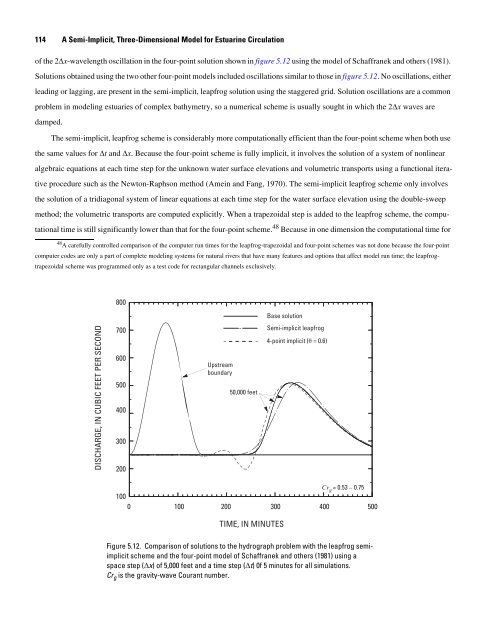A Semi-Implicit, Three-Dimensional Model for Estuarine ... - USGS
A Semi-Implicit, Three-Dimensional Model for Estuarine ... - USGS
A Semi-Implicit, Three-Dimensional Model for Estuarine ... - USGS
You also want an ePaper? Increase the reach of your titles
YUMPU automatically turns print PDFs into web optimized ePapers that Google loves.
114 A <strong>Semi</strong>-<strong>Implicit</strong>, <strong>Three</strong>-<strong>Dimensional</strong> <strong>Model</strong> <strong>for</strong> <strong>Estuarine</strong> Circulation<br />
of the 2Δx-wavelength oscillation in the four-point solution shown in figure 5.12 using the model of Schaffranek and others (1981).<br />
Solutions obtained using the two other four-point models included oscillations similar to those in figure 5.12. No oscillations, either<br />
leading or lagging, are present in the semi-implicit, leapfrog solution using the staggered grid. Solution oscillations are a common<br />
problem in modeling estuaries of complex bathymetry, so a numerical scheme is usually sought in which the 2Δx waves are<br />
damped.<br />
The semi-implicit, leapfrog scheme is considerably more computationally efficient than the four-point scheme when both use<br />
the same values <strong>for</strong> Δt and Δx. Because the four-point scheme is fully implicit, it involves the solution of a system of nonlinear<br />
algebraic equations at each time step <strong>for</strong> the unknown water surface elevations and volumetric transports using a functional itera-<br />
tive procedure such as the Newton-Raphson method (Amein and Fang, 1970). The semi-implicit leapfrog scheme only involves<br />
the solution of a tridiagonal system of linear equations at each time step <strong>for</strong> the water surface elevation using the double-sweep<br />
method; the volumetric transports are computed explicitly. When a trapezoidal step is added to the leapfrog scheme, the compu-<br />
tational time is still significantly lower than that <strong>for</strong> the four-point scheme. 48 Because in one dimension the computational time <strong>for</strong><br />
48 A carefully controlled comparison of the computer run times <strong>for</strong> the leapfrog-trapezoidal and four-point schemes was not done because the four-point<br />
computer codes are only a part of complete modeling systems <strong>for</strong> natural rivers that have many features and options that affect model run time; the leapfrog-<br />
trapezoidal scheme was programmed only as a test code <strong>for</strong> rectangular channels exclusively.<br />
DISCHARGE, IN CUBIC FEET PER SECOND<br />
800<br />
700<br />
600<br />
500<br />
400<br />
300<br />
200<br />
Upstream<br />
boundary<br />
50,000 feet<br />
Crg = 0.53 – 0.75<br />
100<br />
0 100 200 300 400 500<br />
TIME, IN MINUTES<br />
Base solution<br />
<strong>Semi</strong>-implicit leapfrog<br />
4-point implicit (θ = 0.6)<br />
Figure 5.12. Comparison of solutions to the hydrograph problem with the leapfrog semiimplicit<br />
scheme and the four-point model of Schaffranek and others (1981) using a<br />
space step (Δx) of 5,000 feet and a time step (Δt) 0f 5 minutes <strong>for</strong> all simulations.<br />
Cr g is the gravity-wave Courant number.

















